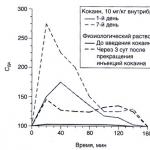Probably every gardener has thought about how to grow watermelon in the country. With desire and a little patience, it is easy to achieve good results in this matter. Quite simple agricultural technology will allow you to get a harvest, including for a novice gardener, and even for a child.
Selecting seed material
You can also grow watermelon seedlings from a watermelon seed purchased in a store, but in this case you cannot guarantee a good result, since the fruits of the daughter plant are unlikely to be similar to the mother ones. That is, if you purchased an unusually tasty, sweet, juicy watermelon, then the fruits grown from its seeds will certainly differ in taste. Therefore in in this case It is better to purchase high-quality seed material at specialized sales points.
As for the choice of variety, then experienced gardeners It is advised to purchase hybrid varieties, since they are the ones that are more adapted to changeable weather conditions and the climate in which we live, and are also the most resistant to possible diseases. Among hybrid varieties the most famous are the following:
- Astrakhan;
- Madeira;
- Sympathy F1;
Video about growing watermelons
However, if you are going to grow a watermelon for the first time, then you can experiment by choosing for planting, but preferably still early ripening ones, such as Ogonyok, Sugar Baby, etc.
It is necessary to begin work at the end of March - mid-April, then young plant will have time to gain strength and will tolerate transplantation to a permanent place of growth well. A composition consisting of the following components is ideal as a soil mixture:
- turf land;
- humus or peat;
- wood sawdust.

Work should begin at the end of March - mid-April
All ingredients are taken in equal parts and mixed well. It also makes sense to purchase ready soil and use it. As containers for growing seedlings, it is better to take individual cups or pots with a depth of at least 10-12cm.
When planting seeds, it is worth considering that they are covered with a thick shell, which is why germination takes quite a long time. To speed up the process, the seeds should be softened a little by heating them in warm water(50-55 0 C) for 10 minutes, and then leave in a wet cotton cloth until “pipping”, making sure to retain moisture. Instead of fabric, you can use hydrogel, which lately is gaining popularity among gardeners.
After the seed has “opened” and the length of the sprout has reached 1-2 mm, it is important to harden the planting material. In this case, it is recommended to use one of two options:
- Fill a deep container with snow or put ice in it, and sprouted seeds on top. Leave them like this for 5-6 hours.
- Take a small piece of cotton cloth, moisten it with water and wring it out thoroughly. Place the hatched seeds in a damp cloth and place them in this form in the refrigerator for 5-7 hours.

When planting seeds, it is worth considering that they are covered with a thick shell, which is why germination takes quite a long time.
There is no need to worry that the sprouts will freeze and become unviable; on the contrary, such hardening is the best prevention against many diseases. These measures will allow the plant to strengthen and become less susceptible to weather conditions.
After hardening is completed, the germinated material can be planted. The seed is lowered into the prepared soil to a depth of 3-4 cm, and carefully sprinkled with earth on top. Water the plantings thoroughly, without overwatering, but the soil should be well moistened.
Next, before germination, you will need to cover the containers with the plantings with film, forming something like a greenhouse. In general, it is recommended to use simple plastic bags and rubber bands for this. Before the sprouts appear, the containers are left alone, making sure that the soil in them does not dry out. After the sprouts have appeared, the film is removed and the seedlings are placed on permanent place. The following measures are recommended for caring for seedlings:
- timely watering. Watermelon loves moisture, so you need to make sure that the soil is moist all the time and not allow it to dry out. However, since the crop is prone to root rot, overwatering should not be allowed, as this leads to the loss of seedlings;
- additional illumination. To prevent seedlings from stretching, it is important to extend daylight hours to 10-12 hours using a simple table lamp;

Watermelon loves moisture, so you need to make sure the soil is moist all the time.
- Feeding. It is allowed to feed the seedlings a week after emergence. In the best possible way A solution of mullein in a ratio of 1 to 10 is suitable.
Seedlings are considered ready for planting if the plant already has 3-4 leaves, is fairly stocky and has a developed root system.
Of course, greenhouse conditions are better suited for growing watermelon. However, those gardeners who do not have the opportunity to plant a plant in a greenhouse receive wonderful harvest, V open ground.
To grow melons in open ground, choose the brightest and warmest place, preferably with sandy loam or sandy soil (ideal acidity 6-7). The predecessors of watermelons should not be allowed to be nightshade or melon plants, due to common pests.

To grow melons in open ground, choose the brightest and warmest place
The bed for watermelons is prepared in the fall. The earth is carefully dug up with half-rotted manure or humus. When digging, you must be careful about removing weed roots, since watermelon strongly dislikes such “neighbors.”
In the spring, as soon as the snow melts and the threat of day and night frosts has passed, the ground is thoroughly loosened and covered with black non-woven fabric or transparent film. Both options are possible, but many gardeners choose transparent film, as it has a number of advantages:
- reduces evaporation from soil in hot weather;
- prevents the soil from becoming waterlogged during the rainy season;
- keeps fruits dry and clean during their growth period;
- the ground under the film is warm and moist.
After allowing the ground to warm up, small cross-shaped holes are made in the covering material for planting seedlings at intervals of approximately 140x70 cm.
A small hole is made under each hole, into which fertilizers (humus, ash) are added and watered thoroughly. The seedlings, having previously soaked the ground with abundant watering, are very carefully removed from the cups and planted, deepening the plant to the level of the root collar.

It is necessary to ensure that the soil is important, but not swampy
When deciding how to grow a watermelon in the country, do not forget that a plant growing in open ground needs appropriate care:
- Timely watering. It is necessary to ensure that the soil is important, but not swampy. Watering is best done in the evening. Be careful not to let water get on the leaves of the plant.
- Weeding. I really don't like watermelon unwanted neighbors, so weed removal should be regular.
- Monitoring the growth of lashes. They must be directed in one direction, making sure that they do not intertwine with each other as they grow.
- Feeding. The first feeding is carried out a week after planting the seedlings in the ground. Follow the instructions for the fertilizer used. However, fertilizing should be stopped after fruit set in order to reduce the accumulation of nitrates in watermelon fruits to a minimum.
- Regular inspection of plants for pests and diseases.
- Pollination. If you do not rely on insects, then you need to pollinate manually using a special brush, which can be purchased at the store.
Growing watermelons in a greenhouse
Before planting seedlings, the soil in the greenhouse must be prepared by carefully digging it up with humus. It is worth planting plants in a greenhouse only when the threat of frost has passed; it is optimal if the daytime air temperature reaches 20-25 0 C, and at night does not fall below 5 0 C.
Video about growing watermelons in a greenhouse
Planting seedlings is done in the same way as in the case of open ground, taking into account only that the distance between plants should be 70 cm, and row spacing - 50 cm. Otherwise, nothing can be changed.
Growing watermelons in a greenhouse requires proper care of the plant. In addition to everything described above, it is necessary to pay more careful attention to pollination, since it can be difficult for insects to get inside. In addition, when growing watermelons in a greenhouse, in addition to the main list, it is necessary to carry out ventilation. On hot days summer days, at temperatures above 30 0, be sure to open the windows or doors in the greenhouse.
If you follow certain rules, you can get a good harvest of watermelons in your garden or dacha. This crop requires long and warm summers. You can plant watermelons in open ground in all regions of Russia, with the exception of Siberia.
Caring for striped berries should include watering, thinning, fertilizing, loosening the soil and pruning. Watermelons are susceptible to diseases such as powdery mildew, olive spot, and rot. In case of infection, watermelons are treated with fungicidal preparations.
Features of growing different varieties
The plant is native to Africa. The culture belongs to the Pumpkin family. The stems of watermelon are thin and highly branched. They can be curly or creeping. They can reach 4 m in length. Young leaves have thick pile. Then they become rough, hard, and have an egg-triangular shape. In length from 7 to 23 cm. Inflorescences are female, male and hermaphroditic. They have a boat shape. The fruit is a berry with many seeds. The flesh is usually pink or red, and outer shell green (usually with light stripes).
There are many varieties of watermelon, but they are all conditionally divided into 2 types - woolly watermelon and African tsamma melon (wild species).
All varieties are divided into 3 groups.
Early ripening ones include:
- Skorik.
- Victoria.
- Ogonyok.
- Dolby.
- Stabolite.
- Jenny.
The following are considered mid-season:
- Ataman.
- Lazy-sided.
- Top gun.
- Atey.
- Dumara.
The later ones include:
- Spring.
- Icarus.
Currently, even varieties have been bred in which the fruits have a lemon taste and the flesh is yellow. There are also hybrids with black skin.
The following varieties can be grown in the Moscow region:
- 1. Skorik. The fruit is in the form of a ball weighing no more than 3 kg.
- 2. Light. The harvest is stable, but small. Typically the weight is up to 2 kg.
- 3. Crimson Sweet. Translated as “raspberry sugar”. Among early ripening varieties The largest fruits are up to 8 kg.
- 4. Lazy. Fruits up to 4 kg. They have a fairly long shelf life - up to 3 months. Thanks to this, you can enjoy this watermelon even on New Year’s Eve.
In Siberia, watermelons can only be grown in greenhouses. They must be strong. Polycarbonate or glass are suitable. In addition, another feature of growing watermelons in Siberia is that only seedling method, but seeds cannot be placed in open ground.
The most suitable varieties of watermelon for Siberia are the following:
- 1. Chill. Withstands low temperatures well. The variety is early ripening. The growing season takes no more than 100 days. Fruits weigh up to 7 kg. The pulp is juicy and sweet. Another advantage is the long shelf life of the berries - up to 1 year. It has good transportability.
- 2. Ultra early. This variety is considered quite early ripening. Its growing season lasts up to 2.5 months. The pulp of the berries is sugary. They weigh 4-5 kg.
- 3. Photon. This mid-early variety. It takes 80-100 days to ripen. The plant is not demanding on the soil, is resistant to diseases, the number of seeds in the berry is small, and the pulp is tender. The weight of the fetus is 3-6 kg.
- 4. Charleston Gray. The variety is recognizable elongated shape large fruits. They weigh up to 10 kg. The culture is unpretentious in care.
- 5. Siberian Lights. This variety was bred specifically for areas with harsh climatic conditions. The plant is resistant to low temperatures, lack of lighting and drought. The crop almost never suffers from fusarium. The bark of the berry is dark, without stripes. There are few seeds. Fruit weight - up to 4 kg.
- 6. Siberian Giant. This is another variety that is bred for northern latitudes. It is characterized by frost resistance, large size (the fruit weighs up to 7 kg), and long shelf life.
- 7. Ultra early ripening. The fruits are stored for a long time. The plant is resistant to powdery mildew and anthracnose. The culture is unpretentious in care.

Landing rules
Watermelons can be propagated through seeds and seedlings. The first option is suitable for regions with warm climatic conditions.
Sowing seeds should be done in the spring as follows:
- 1. Select a site. The soil on it should have time to warm up to 13 0 C.
- 2. Soak the seeds in clean water until the sprouts hatch.
- 3. Make holes in the area. They should be 10 cm deep. The distance between the holes should be 1 m.
- 4. Place fertilizer in the hole. It is recommended to mix humus with 1 tsp. ammophoska and 1 tbsp. l. wood ash.
- 5. Place the seeds there and sprinkle with substrate.
The first shoots usually appear within 1.5-2 weeks. If you plant watermelon seeds in open ground in regions with a cold climate, you must wait until the end of May or the beginning of June. You can also plant under film - a kind of greenhouse. In this case, the harvest is obtained much earlier. Some people prefer to cover the space between the holes with black film. This attracts the sun's rays and prevents the rapid evaporation of moisture from the soil.
Another method is seedling. It is suitable for northern regions.
Landing is carried out as follows:
- 1. Prepare the substrate correctly. It is recommended to mix peat, fine sand and turf soil.
- 2. Select pots. They should be large and wide. You need to make holes at the bottom to drain excess water.
- 3. Place watermelon seeds in special containers. This is recommended to be done in late spring. Keep containers in a warm place with a temperature of about 30 0 C.
- 4. Care for sprouts. Water the seedlings periodically. It is necessary to ensure that water does not get on the seedlings. If necessary, you need to turn on additional lamps to improve lighting.
- 5. Carry out hardening. This should be done 2 weeks before planting the sprouts in open ground. It is necessary that they get used to such conditions. For this purpose, a container with planting material should be taken outside or onto the balcony for 1-2 hours. Gradually you need to increase the interval - add an hour every day.
Mandatory preliminary preparation area before moving the seedlings into open ground. The soil should be well heated and loosened. The place should be chosen with protection from strong winds and drafts. Watermelon seedlings feel best in areas where legumes, alfalfa, and cabbage were previously grown. You should not choose a place where eggplants, potatoes, tomatoes, bell pepper. Ideal option is sandy loam or sandy soil. It is necessary to add potassium compounds and superphosphate to it. If the soil is too heavy, then fine river sand is added to it.
Planting watermelon sprouts in open ground is as follows:
- 1. Dig holes. The distance between them should be 1-1.3 m. 1.5-2 m should be left between the rows. It is recommended to place the sprouts in a checkerboard pattern.
- 2. Deepen the seedlings into the holes and sprinkle with substrate. There should be shoots with leaves on top.
- 3. Place sand near the seedlings. It will prevent diseases such as root rot.
- 4. Water the seedlings.
In the future, all that remains is to take care of the culture.
Nuances of care
Watermelon care is as follows:
- 1. Thinning the sprouts. As soon as they appear, some need to be pulled out - only the weak or sick ones. If healthy seedlings sprouted too close to each other, they can be planted in different places.
- 2. Watering. It should be timely and regular, once a week. For 1 sq. m of plot is required 3 liters of water. It should be poured not only at the root of the plant, but also in the places between the rows. It is best to use rain or settled water at room temperature. During hot weather, it is necessary to water the crop twice a week. When the fruits begin to appear, watering must be gradually reduced, and 2 weeks before the berries are picked, it should be stopped completely.
- 3. Loosening the soil. This must be done the next day after watering. By loosening the soil, the roots gain access to oxygen. At the same time, you can remove weeds. The grass is not dangerous for watermelon, since it root system quite branched. Weeding should be done carefully so as not to damage it.
- 4. Feeding. The first time it should be carried out 2 weeks after planting the crop. To do this, use chicken manure, mullein or ammonium nitrate. As for the last substance, you will need 20 g of product per 2 liters of water. This is enough for one bush. If you use mullein, you will need to prepare a solution in a ratio of 1:10. When using chicken manure, you need to make a solution in a ratio of 1:10. For each bucket of such solutions, it is necessary to add another 15 g of double superphosphate and the same amount of calcium chloride. The second time fertilizing should be done when the fruits begin to set. In this case, it is recommended to use superphosphate and ammonium nitrate. You can mix 4 g of calcium chloride and ammonium nitrate with 3 g of double superphosphate. This is enough for 1 bush. Fertilizers are supposed to be applied in powder form, but then you need to water the crop. The mixture can be dissolved in water.
- 5. Trimming. No more than 5-6 fruits should be left on one bush. They should be the largest and healthiest in appearance. The rest will have to be cut off, otherwise all the fruits will not be able to develop fully.
As for diseases, watermelon suffers from the following:
- 1. Powdery mildew. A whitish-gray coating appears on the leaves.
- 2. Peronosporosis. Also called false powdery mildew. Not only a gray coating appears on the leaves, but also yellow spots.
- 3. Anthracnose. Pink-yellow pads form on the leaves.
- 4. Olive spot. Spots appear on leaves and stems irregular shape. The latter also become corrugated.
- 5. Bacteriosis. Oily patches appear on leaves and stems.
- 6. Rot. It comes in root, black, white and gray. The cause is a fungus.
- 7. Cucumber mosaic. The disease cannot be cured. A peculiar pattern appears on the leaves.
Although watermelon is considered an unpretentious crop, with improper care such diseases develop quite quickly. Fungicides control fungal infections. From bacterial and viral plant it will not be possible to save. Among the insects that are dangerous for watermelon are cutworms, wireworms and melon aphids. Insecticides help with them.
Watermelon is a melon crop. Its growth is associated with a warm climate. But currently this crop is grown in various climatic conditions in their gardens and greenhouses. Read the article about when to plant watermelons so that they reach ripeness.
Description of watermelon
This plant survives due to its long stems, which reach from the deep layers of the soil. nutrients for the fetus. Their length reaches four meters or more. They are curly in structure. Despite the fact that the stems are thin, they are able to withstand large fruits. The leaves are ovoid in shape and have pubescent edges. They grow in length up to 10-20 cm, and in width - from 6 to 17.
The flowering period of watermelons begins in summer. Their fruits are considered berries, and many people find this unusual. Under the dense, thick crust there is juicy, tasty, sweet and very aromatic pulp with a large number of large seeds.
How to choose the right site and prepare the soil?
The growth and development of plants, the formation and ripening of their fruits largely depend on how to carry out preparatory work. What is needed for this?
- To get good harvest watermelons, you need to create normal growing conditions for them. First of all, a site is selected that throughout the entire daylight hours will be heated by the sun's rays and not blown through strong winds. It is important that there are no drafts.
- The seedlings quickly take root and grow well in the area previously occupied by onions, alfalfa, cabbage, and legumes. There is no need to plant watermelons in those beds where eggplants, tomatoes, peppers, and potatoes previously grew.
- Once you have decided on the site, you should begin preparing the soil. Watermelons are suitable for sandy and sandy loam soils. While the area is free of plants, it needs to be fertilized with manure, potash fertilizers, superphosphate. If it turns out that the soil in the area is heavy, it needs to be discharged. To do this, it is enough to add fine-grained sand, otherwise the watermelons will grow and bear fruit poorly.

Preparing seeds for planting
To plant watermelons, planting material must be prepared. The stages of this procedure are as follows:
- First, calibration is done, for which you need to pour the seeds onto a horizontal surface and arrange them in separate piles, focusing on the sizes. For large, medium and small seeds, containers with appropriate parameters are prepared. This will increase their germination rate: large specimens will not suppress small ones. The seeds will sprout together and grow evenly. Small specimens do not need to be thrown away. They are suitable for planting, only the seedlings from them will bear fruit later.
- The second stage is scarification. It is not necessary to do this, but it is advisable. This is done to make it easier for the sprout to come to the surface. To do this, just rub the “nose” of the seed sandpaper with fine texture.
- Then the seeds are heated. To do this you need to place them in hot water for 30 minutes. The procedure cannot be ignored; it is mandatory for watermelons.
- After this, the seeds are disinfected by placing them in a solution of potassium permanganate for 20 minutes.
- The last stage is drying the seeds. This should be done not on a radiator or in the oven, but naturally. The seeds are laid out in one layer on a horizontal surface of a table or floor outside under a canopy. It is imperative to exclude exposure to the sun and drafts.

To increase germination. Before drying, wrap them in a soft cloth made of natural fiber and moisten it clean water and place it on a plate next to a heat source. The condition of the cloth must be constantly monitored; it should not dry out. If necessary, it is moistened.
How to plant watermelons with seeds?
If the crop is grown in regions where a warm climate prevails, then the seeds do not need any preliminary preparation other than soaking. When the sprouts hatch, they are immediately sown in the ground. Read below on how to plant watermelon seeds.
- In the spring, when the snow melts, under the influence sun rays the soil will begin to warm up. You need to wait until its temperature reaches +13 °C. The seeds should be kept in a container of water warmed to room temperature until they germinate.
- A site for planting is selected in a garden or country house. Holes are made throughout its entire area, their depth is 10 cm. The distance between them should be large. About one meter.
- Then, independently prepared fertilizer is poured into the bottom of each hole: humus is mixed with a tablespoon of ash and a teaspoon of ammophoska.
- After this, the seeds are placed in the hole, covered with soil and waited until they sprout. This happens after two weeks or a little earlier.
- Planting seeds in regions where cold climate, carried out at other times. When to plant watermelons in this case? Taking into account climatic conditions, seed planting should be carried out at the end last month spring or early summer.
When to plant watermelon seedlings? It depends on the region of growth and the method of cultivation. If watermelons are grown in open ground, seeds are sown in pots (for example, in the Moscow climate zone) at the beginning of April. When to plant watermelon seedlings? Everyone has climate zone The timing of sowing seeds in pots varies. This is agreed in lunar calendar.

To sow watermelons for seedlings, use small containers, it is better if they are peat. Soil is poured into them, but not to the very top, but three to four centimeters below. Then they start sowing the seeds. Three, four or five pieces are planted in each pot. They are buried only four centimeters into the soil, no more, otherwise they will take a long time to germinate.
The pots are covered with film - it will protect the soil from drying out. Then they are transferred to a cool place with an air temperature of +17...+20 °C. It is very important that the surface of the soil in pots is always moist. This is clearly visible through the transparent film. Before the emergence of seedlings, the film is not removed, and the crops are periodically watered with settled water at room temperature.
After about seven days, shoots will appear. If the seeds were not germinated before planting or were planted deep, this will happen a little later. For pots with young plants, choose a place indoors that is well lit by the sun. It is important that the temperature is within the acceptable range: +16...+24 °C. In order for the seedlings to get used to low temperatures, they need to be taken outside for a short time. When to plant watermelons? This should be done when the seedlings are strong enough - then they will quickly take root in a new place.
Planting watermelon seedlings
How to plant watermelons in open ground correctly? In order for these plants to grow comfortably in the chosen area, the soil is first dug up and well loosened. It is recommended to plant seedlings 30 days after sowing the seeds. This time falls on the last week of May or the first ten days of June. The best time The best time for landing is before noon. How to plant watermelons in open ground? The landing technology is as follows:

- Holes are dug with a depth and diameter of up to 50 cm. Gaps of one meter are left between them. It is better to arrange the holes according to the chess principle.
- In each hole you need to add: humus, sand, superphosphate - 5-7 l, 3 l and ¼ part of a glass, respectively.
- The hole is filled with loose soil from above to form mounds. small size.
- Holes are made to a depth of 10 cm, and 0.5 liters of water is poured into each.
- The seedlings are taken out of the cup, lowered into the hole, and covered with earth, which is compacted well. Above trunk circle The plants are covered with a thick layer of sand.
- The seedlings are watered and covered for a while to avoid direct sunlight on the leaves, otherwise they will take a long time to rise.
Caring for seedlings in open ground
The planted plants are stressed because they were placed in new environment. To make the acclimatization process faster, the seedlings need to be looked after.
- Thinning. This procedure is carried out with the appearance of three or four leaves. The plants are thinned out, one or two are left in the hole, all the rest are removed.
- Weeding. Watermelons are very clean plants; they do not tolerate weeds. Therefore, you will have to fight them often, especially at the beginning of growth. Very soon the seedlings will grow up and take on the appearance of bushes, and then the frequency of weeding will be reduced. Weeds will no longer be able to harm mature plants.
- Topping. This is done so that the lashes grow faster. Curly shoots should be pinched at the level of the top two or three leaves. At the same time, weakened lashes are removed. Three to five ovaries are left on each bush.
- Loosening. This procedure is carried out constantly, since watermelons prefer airy soil.
Watering
When we plant watermelons in the ground, we need to be prepared for the fact that they will have to be watered frequently, otherwise they will not absorb juice well. Striped berries need to be watered regularly, once a week, or twice in hot weather. For this they use a lot of water: three buckets per meter square area plot. It is necessary to moisten not only the watermelon bushes, but also the free area between them. With the appearance of fruits, watering is reduced, and before harvesting, it stops altogether (two weeks before).
Top dressing
Plants need it within a couple of weeks after they are planted in the ground. Used as fertilizer aqueous solution ammonium nitrate. One bush will require two liters. The second feeding is done when the buds begin to form. Calcium chloride, 5 g of ammonium nitrate, and 1 g more of superphosphate are added to one bush.

Planting watermelons in a greenhouse
Watermelons are a heat-loving crop. In the distant past, they were grown in regions suitable for such climates. But now there are opportunities to obtain tasty fruits in cold climates. Only here they grow not in open ground, but in greenhouses. How to properly plant watermelons in a greenhouse?
- First you need to plant the seeds in boxes with soil. Allocate a place indoors for planting to place containers with planting material.
- Then the beds are prepared for planting watermelons. This is done like this: remove from the soil top layer, a trench is formed. Humus is poured into it, nitrogen fertilizers and on top - the soil.
- After this, the seedlings are transplanted into the beds (they will sprout from the seeds by this time). The plantings are covered with polyethylene film in two layers. When to plant watermelons in a greenhouse? Optimal time for this procedure is the end of April.
- To plant sprouts, dig holes of shallow depth - from 10 to 11 cm. Gaps of 70-100 cm are left between them.
- A trellis needs to be installed near each hole. It is needed to tie growing stems to it, since they are climbing and they need to cling to something.
- To improve the fruiting of watermelons, you need to introduce bees into the greenhouse, but not a whole swarm, but several individuals. They will pollinate the flowers.
- When the shoots begin to sprout intensively, they should be cut off immediately, but first of all, the weak and sick ones should be removed.
- As plants grow, they need beneficial supplements, so they should be fed with mullein or chicken droppings.
- Required condition To grow watermelons in a greenhouse, it is necessary to regularly ventilate it. There is no need to forget about this.
Caring for watermelons in a greenhouse
When the growing vines begin the flowering period, watermelons must be pollinated by hand, otherwise ovaries will not form. Each lash in greenhouse conditions can withstand a load not exceeding two fruits. But if you leave only one striped berry, it will be much larger.

Watermelons are grown using a trellis. Each fruit is wrapped to prevent it from coming into contact with the ground. Watermelons growing in a greenhouse are much weaker than those growing in melon fields. Their lashes cannot support the weight of the fruit and fall to the ground. If they are not wrapped, they may rot.
If many side shoots have formed and they branch in the direction other than the support, they are cut off. Plants need to be constantly turned towards the sun, as the lashes need good lighting, otherwise leaves and fruits will form poorly.
Some plant growers are interested in how to grow watermelon on their site. Everyone has such an opportunity today, and has been for quite some time. This is due to the developed hybrid and early varieties. However, to plant and obtain a harvest in the form of juicy fruits with excellent taste, you need to know about some nuances.
Preparing and planting seeds
Experts note that the most problems arise with watermelon seeds when grown compared to other members of the melon family. To begin, the seeds need to be placed in slightly salted water. Seeds suitable for planting will sink to the bottom, while lighter and weaker ones will remain on the surface.
But this will not be enough if the crop is grown using this method. 1-2 days before planting, watermelon seeds should be kept for 3-4 hours at temperature indicators at 55 degrees or leave for 6-7 days in the sun so that the sowing material is thoroughly disinfected. After disinfection, the seed should be left in warm water for a day. This way you can speed up their germination.
In the southern regions and the Black Earth Region, where juicy watermelons are grown right in the country or in the territories industrial use, the plant can be planted immediately open ground seed method. Optimal time for this purpose, it occurs when the soil heats up to 12-16 degrees at a 10-centimeter depth. The dimensions of the furrows for planting seeds depend on the size of the seed.
Any representatives of melons need plenty of food during ripening. It is provided by a massive root system and individual roots that are formed on special loops. Therefore, to plant a watermelon, you need to choose a spacious place, the size of which depends on the type of plant and the type of soil. For example, experts advise the following:
- If the crop is planted in several rows, then an interval of 0.6 m to 1.6 m should be left between them. The distance between individual rows should not be less than 1.5 m.
- Using a square placement scheme, you need to leave at least 0.8 m and no more than 2.1 m between crops.
It is important to ensure that the plantings do not become too dense over time, since in this case the berries will lack nutrition, liquid and light.
Growing watermelon from seedlings
In Russian regions, in cold conditions, it is preferable to grow this berry using seedlings. From sowing in pots to planting watermelons in open ground, it takes from 20 to 40 days. For initial sowing, it is recommended to use small peat pots. They need to be filled with a special mixture of the following substances, taken in equal proportions:
- peat;
- turf soil;
- humus.
 The seeds are placed in moist soil to a depth of 3-5 cm, and then covered with film until the first shoots appear. The temperature of the space under the polyethylene should be about 25 degrees.
The seeds are placed in moist soil to a depth of 3-5 cm, and then covered with film until the first shoots appear. The temperature of the space under the polyethylene should be about 25 degrees.
After the sprouts appear, the seedlings are removed to a cool room. In the first 3-4 days you need to maintain a temperature of about 17 degrees, and then temperature regime can be increased again.
Watermelons should be watered with water at room temperature, avoiding getting it on the leaves. A week after the detection of seedlings, the root system of the plant must be fertilized with phosphorus and nitrogen fertilizers.
Due to the fact that melons love light and warmth, illuminated greenhouses are selected for watermelon seedlings. However, about 1.5 weeks before planting them in open soil, the plants need to be hardened using a special technology. For this purpose, the shoots are taken outside for several hours, after which the duration is increased. Planting on the beds can be done as early as late May or early June.
Selection of soil and site
To achieve excellent yields, a number of conditions must be met. To do this, you should prepare the place in advance:
- it must be sufficiently illuminated;
- protection from strong winds is required;
- the soil should be as nutritious as possible.

Loose, fertile and light soil is more suitable for watermelons. The best option -
sandy loam or sandy soil, saturated with humus and any other organic matter.
The predecessors of melons can be potatoes, tomatoes, radishes, cabbage and cruciferous vegetables. Before growing watermelons in open ground, you need to properly nourish the soil and prepare the beds. For 1 m of furrow in mid-spring you need to add:
- 20 g of fertilizers containing calcium;
- 40 g superphosphate;
- 30 g ammonium sulfate.
 The holes need to be moistened in advance. They need to be placed 1-1.6 m apart from each other, immersing peat cups inside. Then the furrow is mulched using sand mixture and protect from direct sunlight. The same is done after the first shoots emerge (when growing early watermelons in open ground from seeds). Until the plants adapt to new conditions, they are watered warm water.
The holes need to be moistened in advance. They need to be placed 1-1.6 m apart from each other, immersing peat cups inside. Then the furrow is mulched using sand mixture and protect from direct sunlight. The same is done after the first shoots emerge (when growing early watermelons in open ground from seeds). Until the plants adapt to new conditions, they are watered warm water.
Feeding and watering
It is impossible to grow a watermelon at home without providing it with proper fertilizer and sufficient watering. If it does not have enough moisture, then it is pointless to expect sweet and juicy fruits. However, it is also not recommended to be too zealous: otherwise, you will also not be able to get high-quality berries. It’s better to stick to it before flowering moderate watering, and when the ovary is forming, slightly increase the water consumption.
Experienced gardeners advise using drip irrigation systems that will provide plants with regular and high-quality watering.

When growing watermelons in the country, you should remember that they prefer abundant but infrequent watering. The optimal degree of soil moisture is 85%. On sandstone, the furrows need to be moistened a little more often, and on loams and chernozem - a little less often. After the fruits are filled, they begin to ripen. During this period, watering should be gradually reduced and then stopped completely.
During the growth of vines on the plant, they need to be additionally fed by reducing the concentration of potassium and phosphorus-containing fertilizers. When the ovaries begin to form, each plant must be provided with the following substances:
- 30 g of potassium salts;
- 10 g superphosphate and double more ammonium sulfate.
Reducing the dosage of fertilizers is due to the risk of accumulation harmful substances in berry pulp. Besides, similar measure will contribute to more active fruit ripening.
Features of care
To grow healthy and fruitful watermelons, they need to be provided with timely and proper care. It includes:

The soil under watermelons needs to be loosened not only immediately after planting them, but also after heavy rainfall and watering. This must be done until the leaves and lashes cover the voids between the bushes.
To protect lashes and branches from the wind, they can be secured with pins. You can also sprinkle problem areas with moistened soil. If moisture often accumulates at the place where watermelons grow and there is no adequate lighting, then in this case special trellises are erected and, after the growth of the vines, the shoots are secured to strong supports installed vertically. A similar method will be useful if there is not a lot of space in the dacha.
When growing watermelon at home using a trellis, it is advisable to leave only one main vine. After the flowering period of the plant, from 4 to 7 berries may appear on it.
If there is a risk of cold weather, the plants need to be protected with a special film or cardboard sheets.
Harvest
 The earliest varieties of watermelons in the central Russian regions can bear fruit only by the second half of August. At dachas, it is not customary to carry out mass harvesting, except in situations where the risk of frost is very high. Ripe berries are cut off as they ripen. warm time year. Determining their maturity is not difficult. To do this, you need to remember the following signs:
The earliest varieties of watermelons in the central Russian regions can bear fruit only by the second half of August. At dachas, it is not customary to carry out mass harvesting, except in situations where the risk of frost is very high. Ripe berries are cut off as they ripen. warm time year. Determining their maturity is not difficult. To do this, you need to remember the following signs:
- dry tendrils and bracts at the base of the leaf;
- smooth stalk, without hairs;
- dull sound when tapping berries;
- the bark is dense with a glossy sheen.
It is recommended to take these signs into account as a whole and only after that start collecting watermelons, otherwise you can cut off the unripe fruits. But if watermelons will be transported or stored somewhere for a long time, then it is recommended to trim them 3-4 days before ripening, since they can ripen in rooms with sufficient temperature without losing their aroma, taste and beneficial qualities.
If the fruits are collected to obtain seeds, then you need to take them completely. ripe berries. Knowing how to plant watermelon at home, you can enjoy tasty and healthy berries every season.
I think that many gardeners want to know about growing watermelons on their land plots as much as possible. Because many people try to grow watermelons in the hope that they will grow a huge, juicy one. sweet watermelon, but in practice the fruits are small and not sweet.
After this bad experience someone gives up on this matter, but others do not give up and begin to look for information about how in their area, for example in the Moscow region, in Siberia, in the Urals, in middle lane grow watermelons.
They also search on the Internet about growing watermelons in a greenhouse, in open ground, seedlings and much more and enter them into a search engine, looking for the necessary information. Therefore, I have collected in this article all the basic recommendations about growing watermelons from start to finish and I hope that this information will be very useful to you.
Well, the introduction is over, let's get down to business.
What is the first thing you need to know in agricultural technology for growing watermelon?
Watermelons love heat and dry summers. If it rains constantly in the summer, then good watermelon you won't succeed. There’s nothing you can do about it, it’s such a sunny berry. Of course, you can plant special hybrids that do well even during the rains, but their taste will still be far from real steppe watermelons.
Why do watermelons absorb so much juicy moisture into their fruit?
The fact is that watermelons form powerful roots, which feed the plant itself. So, in order for these roots to develop well and penetrate deeply, light, sandy loam soils are needed. In dense soils, the roots are not able to develop well and the plant grows poorly.
And one more important condition for growing watermelons, regardless of whether you grow them in the Moscow region, in the Urals or in Siberia, watermelons suffer terribly from weeds. Especially when they are just starting to grow. You can lose your harvest several times due to these weeds, so it is necessary to weed your garden at the dacha in a timely and efficient manner.
If you follow these three rules, then you will definitely have a harvest. Maybe these won’t be 20-25 kg watermelons, but they will still be big, juicy and sweet.
What else do you need to know about the technology of growing watermelons in open ground? 
Good watermelons cannot be obtained from bad seeds, so you should purchase watermelon seeds from trusted suppliers. If the soil is not light enough, then you need to loosen it deeply.
When to sow watermelon seeds? It depends on the weather. Perhaps it will be the last week of April or the beginning of May. In general, you can sow some varieties before June 20, then you will get a late harvest, but also of good quality.
Watermelons are not grown after watermelons, but rather after alfalfa or winter crops.
In order for the crops to sprout together, sow them at the same depth - 7-8 cm. Seed consumption is 6-10 pieces per linear meter. It is better to sow thickly to begin with, but then you will not have to re-sow the seeds in those places where they have not sprouted. Many people believe that it is necessary to sow old seeds rather than fresh ones. But the fact is that old seeds simply produce more female flowers, which means they will produce more fruits, but these will not be watermelons, but watermelons. Why do we need this? We want big watermelons!
How to prepare seeds for sowing?
First, we heat the dry seeds in the bag in the sun until it reaches 55 degrees. If the seeds are wet, then it should not be more than 30 degrees. Then they fill it with water for half an hour and throw away everything that comes up. Then they pour hot water 50-60 degrees. Cool, drain the water. Then they are soaked until pecked for manual planting. If you can’t warm the seeds in the sun, then store the seeds near the radiator from February. Seeds can be treated with a dark solution of potassium permanganate (15-10 minutes and rinse), and then treated with an ash solution (overnight).
Growing watermelons in a greenhouse

Some people grow watermelons in a greenhouse. Interesting experiments on grafting watermelon seedlings to a pumpkin, thus producing very early watermelons. The yield also increases 4 times. True, growing such seedlings is problematic, but in a greenhouse you can harvest a decent harvest from a smaller area.
What varieties to choose for growing watermelons?
If you want to get a harvest at the beginning of July, then sow early hybrids Helen, Trophy, Dolby on film. Varieties such as Producer and Crimson give a harvest by mid-July, but this is only if sown under film. Growing these varieties of watermelons in open ground will give you a harvest by the first ten days of August. By mid-August, the Nice and Unusual varieties will ripen. And the Kholodok watermelon variety will ripen by the end of August. More good varieties for growing in open ground these are Lada, Lesya, Slavia.
Watermelon seed sowing scheme
Row spacing is 2 meters. 5-10 seeds per meter are sown in a row. Subsequently, the strongest shoots are left 1 meter apart between plants. So, I repeat, we make a hole 8 cm deep. Pour 1-2 liters of water into it. We wait until the water is completely absorbed, lay the seeds flat and fill the hole with earth and trample the hole a little. Under no circumstances should you water the hole after this, because a crust will form and all the moisture will evaporate.
How to water watermelons?
Not really. Watering is needed only at the very beginning for the seeds to germinate, and in the future, if you water, the root system will not develop and go deeper, which means that in extreme heat it will not sufficiently nourish the bush. On the other hand, you can pour three buckets per square meter every two weeks. Then the yield will be much greater, but the taste of the watermelon is worse, and it may crack due to watering.

When the fruits bear fruit, you should protect them from crows. If you gape, the crows will instantly ruin the harvest.
How to check watermelon for ripeness?
Usually in the garden, the ripeness of a watermelon is indicated by the drying of the fruit tendril and the leaf opposite it, the so-called spatulas. For some varieties, drying of the next mustache is necessary. But it happens that such an indication of the ripeness of a watermelon is not suitable. It may be that the mustache is still green, but the watermelon is already ripe. Therefore, for some varieties of watermelon, ripeness is determined by a bright spot on the belly. When buying a watermelon, it is believed that a ripe watermelon is the one with a dry tail, but in fact, watermelons are harvested when the stalk is still green, and dry means that the watermelon has been lying and drying for some time. The watermelon will also be sweeter if it is a little crooked, depressed or square.
Now let's separately highlight how to grow watermelons if you are in the Moscow region, Siberia, the Urals or in the middle zone, i.e. in an area where there may be a lack of light, heat, it rains and the soil is not quite suitable:
We select special watermelon hybrids suitable for your area.
We grow watermelon seedlings, preferably grafting them onto a pumpkin.
We loosen the soil very deeply.
We plant it under film, protecting it from cold weather.
We destroy all weeds.
We are waiting for the harvest.
That’s actually the whole technology for growing watermelons. Have a great harvest and sweet watermelons!

















